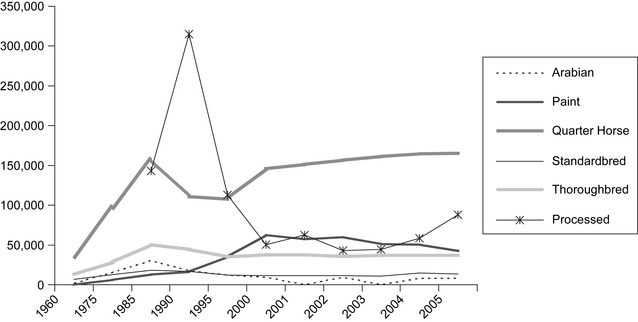CHAPTER 12 The Unwanted Horse: An Overview of the Issue
The issue of the large number of unwanted horses in the United States first came to light after the 2001 foot-and-mouth disease epidemic in Europe. The European consumer’s concern with eating beef resulted in an increase in horsemeat consumption. This change drew media attention to the fact that horses were being processed for meat in the United States and exported to Europe for human consumption. Media coverage of the issue drew not only the attention of the horse-owning public but also equine breed associations, animal rights or welfare organizations, veterinary associations, and members of the public who did not own horses. Because of focused lobbying efforts, federal legislation was introduced in Congress to prohibit shipping, transporting, moving, delivering, receiving, possessing, purchasing, selling, or donating horses and other equids to be slaughtered for human consumption and other purposes. Reports by the media and the proposed legislation fostered for the first time the realization that an unwanted horse problem existed in the United States and had to be addressed.
DEMOGRAPHICS OF THE UNWANTED HORSE
In 2005, approximately 96,000 horses were processed in the United States or exported for processing. That number is down dramatically from the 339,000 horses processed in 1989. As indicated in Figure 12-1, which compares the number of horses registered annually by breed association to the number processed at federally inspected facilities, more horses were processed during the mid-to-late 1980s than in the 1990s, when the number of horse registrations decreased dramatically. Unfortunately, USDA data on the number of horses processed at federally inspected plants prior to 1983 are not available.
Why was there an 80% reduction? Was it simply a surplus reduction, or did the IRS tax code changes implemented in the mid-1980s result in owners selling horses they were no longer able to depreciate? Was there a change in market demand, or were these horses absorbed by rescue or retirement facilities? It appears that the reduction in the number of unwanted horses being processed followed the reduction in number of horses bred and registered in the mid-1980s. Because the United States is a very small supplier of the world horsemeat market, the number of horses processed in the United States is not driven by demand, but rather by the availability of inexpensive horses. The U.S. share of the world equine meat export market is less than 0.5%. In 2005, 4.7 million horses were processed for meat worldwide: China led the world with 1.7 million horses processed, followed by Mexico with 626,000.




